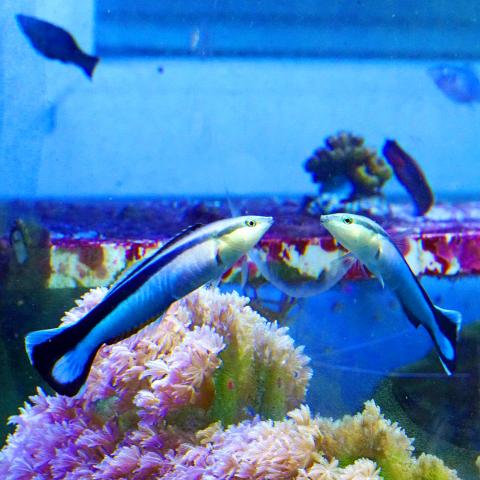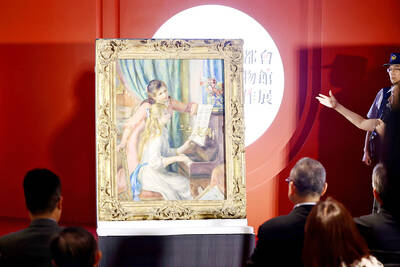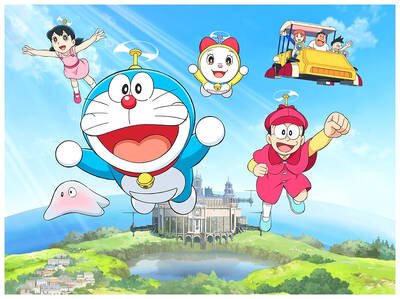A small tropical reef fish was able to recognize itself in a mirror, scientists said on Feb. 7 in a finding that raises provocative questions about assessing self-awareness and cognitive abilities in animals.
The study involved experiments in which the fish species Labroides dimidiatus, called the bluestreak cleaner wrasse, was given a mirror self-recognition test, a technique developed in 1970 for gauging animal self-awareness.
In aquarium experiments at Osaka City University in Japan, the researchers applied a brown-colored mark on the fish’s body in a place that could be seen only in a mirror reflection. The fish tried to remove the marks by scraping their bodies on hard surfaces after watching themselves in a mirror, but never tried to remove them without a mirror present, indicating they understood the reflection was of them, the researchers said. When a transparent, rather than brown, mark was applied, the fish never tried to remove it.

Photo: Reuters
照片:路透
The 10-cm species consumes parasites and dead tissue off skin of other reef fish in a symbiotic relationship. The brown mark’s color resembled the color of these parasites. The fish “shows behaviors during the mirror test that are accepted as evidence for self-awareness in many other species,” said evolutionary biologist Alex Jordan of the Max Planck Institute for Ornithology in Germany, who led the study published in the journal PLOS Biology.
Jordan, however, questioned whether the test represents a reliable measure of animal cognitive abilities. “I don’t claim that fish lack self-awareness, but rather that the minimal required explanation for the behaviors we observe in the mirror test does not require invocation of self-awareness, self-consciousness, or theory of mind,” Jordan said.
The test has been passed by great apes including chimpanzees, bonobos, gorillas and orangutans as well as dolphins, killer whales, an elephant and a magpie species, but failed by some other animals. Humans pass it at around 18 months old. “I consider that there is a spectrum of animal consciousness, with some animals, likely primates, showing abilities closer to human consciousness,” Jordan said. “My point with this paper is not that fish are as smart as chimpanzees, but that the way we ask that very question across taxa (animal groups) needs to be re-evaluated.”
University at Albany evolutionary psychologist Gordon Gallup, who pioneered the mirror test, called the new study “not methodologically sound” and faulted the researchers for a “zeal to undermine the integrity” of the technique to appraise animal self-awareness. Emory University primatologist Frans de Waal, who has studied mirror self-recognition in mammals, called the findings “interesting and provocative.” “The hope is that this study will throw open the discussion about self-awareness in animals. Instead of the black-and-white distinction we have had thus far, that some animals have it and most of them don’t, we need to develop a more gradualist perspective,” de Waal said.
(Reuters)
科學家於二月七日指出,一種小型熱帶珊瑚礁魚類能夠辨認出自己在鏡中的倒影。該研究對於評估動物的自我意識和認知能力,提出發人深省的問題。
這份研究的實驗對象是一種學名為Labroides dimidiatus的魚類,俗稱清潔魚或是藍帶裂唇鯛,科學家對其進行鏡像自我認知測試。這項測試方式發展於一九七○年,是用於判斷動物自我意識的技術。
於日本大阪市立大學進行的水族箱實驗中,研究人員在魚身塗上一塊褐色的記號,位置只能在鏡像中看到。這些魚在鏡中看到自己之後,便藉由在堅硬表面上摩擦身體,試圖抹除掉記號,但這類行為從來不曾發生在沒有鏡子的情況下。研究人員表示,這顯示魚類了解倒影是它們自己的。另外,如果塗上的記號是透明而非褐色的話,這些魚則不曾試圖抹掉。
這種魚類身長十公分,攝食其他珊瑚礁魚類身上的寄生蟲,以及從其他魚身表面剝落的壞死組織,形成彼此互惠的關係。科學家塗上的褐色記號,採用接近寄生蟲的顏色。這篇研究發表於期刊《公共科學圖書館:生物學》,由德國馬克斯普朗克鳥類學研究所的演化生物學家亞歷克斯‧喬丹主持,他表示這種魚「在鏡像測試過程中表現出的行為,在其他許多物種身上會被認可,視為表現自我意識的證據。」
不過,喬丹也懷疑此項測驗是否足以作為動物認知能力的可靠衡量方式。他表示:「我並不是宣稱魚類缺乏自我意識,反而應該是說,我們在鏡像測驗中觀察到的行為,所須最低限度的解釋並不需要訴諸自我意識、自覺、或是心智理論。」
包括黑猩猩、倭黑猩猩、大猩猩,以及紅毛猩猩等大型猿類都曾通過此項測驗,其他通過的動物也包括海豚、虎鯨、一頭大象和一種喜鵲,然而有些動物卻未能通過這項測驗。人類大約在十八個月大時通過測驗。喬丹表示:「我認為動物意識可以視為一個光譜,其中有些動物,例如靈長類,展現出的能力較為接近人類的自我意識。」他進一步指出:「我在這篇論文想要表達的論點並不是說魚類跟黑猩猩一樣聰明,而是我們對整個分類階層(動物族群)提出此問題的方式需要重新評估。」
紐約州立大學奧爾巴尼分校的演化心理學家戈登‧蓋洛普是鏡像測試的先驅,他認為這份新研究「在研究方法上並不健全」,並歸咎於研究人員為了評估動物的自我意識,「熱切想要顛覆該技術的公正性」。埃默里大學的靈長類動物學家法蘭茲‧德瓦爾長期研究哺乳類動物的鏡像自我認知,他認為這份研究「饒富趣味且引發思辯」。德瓦爾表示:「希望這份研究可以開啟關於動物自我意識的討論。與其沿用我們目前非黑即白的區別方式—也就是認定某些動物具有自我意識,而絕大部分則沒有—我們需要發展出一個較為漸進主義式的視角。」
(台北時報章厚明譯)

William I of Prussia, a passionate painter, often autographed his works with “tormentis pinxit” — “painted in pain” — as a nod to his struggles with gout. Other historical figures like King Henry VIII of England and Benjamin Franklin also suffered from this “disease of kings,” which was common among people indulging in luxurious diets. Gout is primarily caused by high levels of uric acid in the body. Uric acid forms as the body breaks down purines, which are found in foods like red meat and seafood. Normally, the kidneys filter out uric acid. However, if the body produces

A: The National Palace Museum (NPM) has launched an exhibition, titled “From Impressionism to Early Modernism.” There are 81 masterpieces from the Metropolitan Museum of Art on display now. B: The exhibit, held to celebrate the NPM’s centennial, must be so spectacular. A: It includes artworks by 38 artists, such as Renoir, van Gogh, Cezanne, Matisse and Gauguin. B: The Fubon Art Museum has also launched an exhibit featuring a number of artworks of Impressionism, including Monet’s “Water Lilies.” A: And the New Taipei City Art Museum just had its grand opening, so there are even more exhibitions

A: What exhibitions are you going to see this summer? B: The 100% Doraemon & Friends exhibit is set to open on June 28. A: The news says there will be a 12-meter-tall giant Doraemon model at the Huashan 1914 Creative Park. B: The One Piece Carnival will set sail on the same day. A: And the D’festa Taipei 2025 – featuring exclusive content from K-pop supergroups such as BTS, NCT and Twice – is also set to begin next Friday. Isn’t that cool? A: 今年夏天還有什麼展覽可看啊? B: 「100%哆啦A夢 & Friends特展」即將在6月28日開幕。 A: 新聞說在華山1914文創園區會場,還有12米高的巨型哆啦A夢呢! B: 航海王「One Piece歡樂派對嘉年華」也將在同日啟航。 A:

The new generation born between 2025 and 2039 has been officially named “Generation Beta,” or simply “Gen Beta.” This generation will be the first to experience a world where artificial intelligence (AI) plays a key role in daily life. Generations are defined by shared cultural, social and historical experiences within a specific time frame. These experiences, often influenced by significant events and technological advancements, shape the values, attitudes and behaviors of each generation. The concept of generations helps us understand how different age groups interact with their environment and contribute to societal changes over time. The previous generational transition from Gen